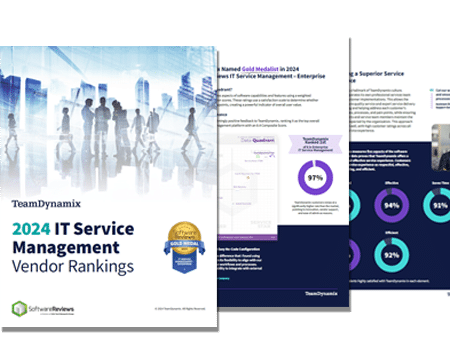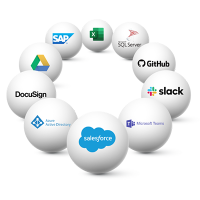
Paving the Way for Better IT Service with the Right ITSM Tool
The construction industry can be very volatile, with a high employee turnover rate due to seasonal fluctuations in the workforce. A key challenge for the

The Info-Tech ranking report offers a unique view of the market based entirely on in-depth customer interviews. Download the Info-Tech ITSM Quadrant and Customer Viewpoint report today.

We’ll show you some of our best situations and show you exactly how to execute them to get immediate results. The best part is, iPaaS tools often feature easy-to-use click and drag functionality, meaning you don’t need a dedicated employee building integrations and workflows.

System Integrators, Value Added Resellers, Technology Providers, and Buying Consortiums can benefit from a partnership with TeamDynamix.

The Info-Tech ranking report offers a unique view of the market based entirely on in-depth customer interviews. Download the Info-Tech ITSM Quadrant and Customer Viewpoint report to gain a better understanding of key vendor strengths and emerging market requirements.
Enterprise Service Management (ESM) is a concept that has been around for quite some time, but it’s only recently gained attention as a key driver of digital transformation. Essentially, ESM involves the extension of IT Service Management (ITSM) principles and practices to other business functions, such as HR, finance and facilities management.
The benefits of ESM are numerous.
By aligning and integrating service management practices across different departments, organizations can achieve greater efficiency, improved customer experience and better alignment with business objectives.
ESM can also help organizations to break down silos and encourage collaboration between teams, which is essential in the fast-paced, interconnected world of digital business.
One of the key ways in which ESM can drive digital transformation is by enabling organizations to take a more holistic view of their services and processes. This can help them to identify areas where automation or other digital technologies can be used to streamline workflows, reduce costs and improve service delivery.
For example, by automating routine HR tasks such as onboarding or benefits enrollment, organizations can free up their HR staff to focus on more strategic activities such as talent development and retention.
Casino Arizona and Talking Stick Resort, have been using ESM for years and just recently switched to TeamDynamix ESM after outgrowing their previous ESM solution.
Independently owned and operated by the Salt River Pima-Maricopa Indian Community in Scottsdale, Arizona, these casino and resort properties employ about 3,500 people altogether. For more than a decade, they’ve benefited from having a “one-stop” service portal that employees could use to request everything from housekeeping services to clean a room before a special event, to the purchase and provisioning of new technology or a security badge for a visiting vendor.
However, the legacy ESM solution these properties were using had serious limitations. For instance, there wasn’t a way for employees to log into the system remotely from a smartphone or other mobile device to track or make service requests on the go. What’s more, making changes to the system’s configuration involved expensive updates to the software’s code.
“Our legacy platform didn’t have the flexibility to grow along with us as our needs evolved,” Program Manager, Adam Dunn, said.
In looking for a new ESM platform, Casino Arizona and Talking Stick Resort wanted the ability to configure the system easily and make changes flexibly and dynamically. “We looked at a number of systems,” Dunn said. “In TeamDynamix, we found the one that was most user-friendly.”
With its “low-code, no-code” design, TeamDynamix is highly configurable, allowing organizations to create personalized service categories (both simple and complex) and build customized workflows for managing multistep processes.
In addition, the platform’s enterprise Integration and automation capabilities allow IT staff to create customized integrations between TeamDynamix and other software programs using a simple, drag-and-drop flow builder. And because TeamDynamix is easy to use and configure, it lends itself nicely to ESM and can be easily adopted by departments outside of IT.
Phase one of the properties’ implementation of TeamDynamix has involved the IT and AV departments. Phase two includes housekeeping and security.
In housekeeping, for example, one of the areas the tool will be used to help with is resource capacity planning around events.
“We have an event space where we host a variety of different things,” Dunn said. “We’ll be using the tool to get out in front of these and schedule housekeeping for room cleanings before and after these events. All of these housekeeping requests can be scheduled and managed through a ticket. This allows our housekeeping department to see what events are upcoming that they need to plan for and staff appropriately. And if we have a performer coming into our nightclubs, a lot of times housekeeping is tasked with clearing space, so they can see when those requests come in and make sure the right resources are available.”
At Pima County, there are plans to use automation both in IT and outside of IT to gain better efficiencies and reduce toil for employees.
Mark Hayes, information technology leader at Pima County, said “[Automation] is something the organization is really just starting to comprehend as a vision that we want to get to overall. My goal and hope is to make sure people understand the possibilities of workflow beyond just getting approvals routed because that’s all that we really do today.”
The county has started by automating user group management and the onboarding/offboarding of employees – a task that involves several departments.
“As a government organization we get audited by the state every year and they want to know what these stale accounts are doing sitting here,” Hayes said. “Offboarding is currently a very manual process – having to review the list from HR of people who are no longer employed with us and manually revoking their privileges from all the different systems and software and disabling their accounts. There’s absolutely no reason for that to not be automated.”
And all of the automation is going to save time and resources across the entire organization.
“The drudgery of working through mundane, repetitive tasks doesn’t exist just in IT,” Hayes said. “I think the more we can reduce toil within the departments that we support, the more people are going to buy in and understand the value of what we’re trying to achieve. There’s nothing like success to breed more success, and once other departments see the benefits they’re going to want these tools too.”
ESM can also help organizations to adopt a more agile approach to service delivery. By breaking down silos and encouraging collaboration between teams, ESM can help organizations to be more responsive to changing business needs and customer demands. This can be particularly valuable in industries such as retail or healthcare, where customer expectations are constantly evolving.
Another way in which ESM can drive digital transformation is by helping organizations to adopt a more data-driven approach to service management. By collecting and analyzing data on service performance, customer feedback and other key metrics, organizations can gain valuable insights into how their services are performing and where improvements can be made. This can help them to prioritize investments in digital technologies and ensure that they are delivering value to their customers.
Finally, ESM can help organizations to build a culture of continuous improvement. By providing a framework for service management that is aligned with business objectives, ESM can help organizations to identify areas for improvement and implement changes more quickly and effectively.
This can be essential in the fast-paced, ever-changing world of digital business, where organizations need to be able to adapt quickly to stay ahead of the competition.
Enterprise Service Management is an important driver of digital transformation. By aligning and integrating service management practices across different departments, organizations can achieve greater efficiency, improved customer experience and better alignment with business objectives. By adopting a more holistic, data-driven and agile approach to service delivery, organizations can build a culture of continuous improvement and stay ahead of the competition in the fast-paced world of digital business.
Want to learn more about Enterprise Service Management? Check out the State of ITSM and ESM Report from InformationWeek.

The construction industry can be very volatile, with a high employee turnover rate due to seasonal fluctuations in the workforce. A key challenge for the

A study from Information Week and TeamDynamix shows companies are looking to invest in IT Service Management (ITSM) software that is simple to administer and

When it comes to improving IT Service Management (ITSM) maturity, many organizations turn to ITIL – a framework that guides users through a process-based approach
TeamDynamix’s award-winning SaaS cloud solution offers IT Service and Project Management together on one platform with enterprise integration and automation.
[email protected]
(877) 752-6196
Contact Us
